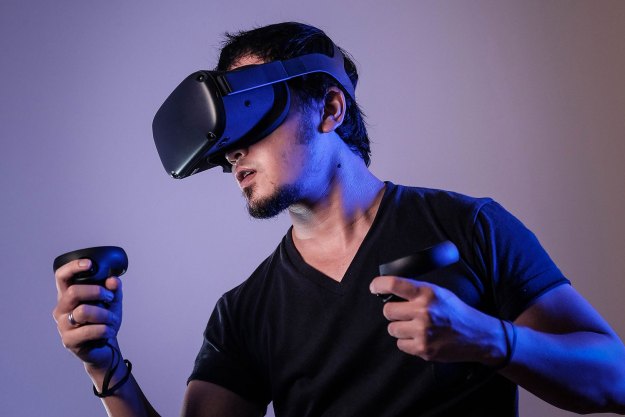The inventors of Reachy, a humanoid, open-source robot created by the French startup Pollen Robotics, have come up with a way to teleoperate the robo-creation through virtual reality. This opens up the possibility of users controlling the robot to carry out potentially complex tasks from anywhere in the world, so long as they’re able to slip on a VR headset to do it.
“Using a VR device — [a] headset and controllers — a human can take full control of Reachy,” Matthieu Lapeyre, CEO and co-founder of Pollen Robotics, told Digital Trends. “You see exactly what Reachy sees in 3D through its dual camera, and Reachy replicates your head and hands motions. You can control the gripper with the controllers’ triggers, and get haptic feedback from the controller vibrations. It’s really like you were ‘in’ the robot to do the job. It works through the network, you can be either close or far away from Reachy, as long as you have a proper internet connection it will work the same.”

The Reachy robot is available either as a standalone arm, costing $9,000, or as a full half-body system, costing $17,000. It’s capable of carrying out a variety of tasks, from doing handwriting to playing games — and its creators refer to it as the only open-source humanoid robot platform available on the market.
With its animated antennae and expressive eyes, along with its versatility, Reachy could potentially be a useful tool for a wide range of applications. Lapeyre said that it is easy to train it to carry out new tasks, without hours spent writing the necessary code. It would certainly fit in nicely as a testing platform for startups or, potentially, as a learning tool for classrooms. The VR application also looks a whole lot of fun that could be used for more serious applications, too. Users may get a chance to try it out soon — even if they’ve not shelled out for a Reachy robot.
“[This] was initially designed to be accessible only by people having a Reachy platform, but we have been overwhelmed by requests from the VR community to [have a go,]Lapeyre continued. “We are now trying to figure out how to offer the possibility for people with VR to play with our Reachy, set-up a fun playground, and [maybe even] stream it on Twitch.”
Editors' Recommendations
- Tesla’s Optimus humanoid robot can now dance like Elon Musk
- Amazon’s new humanoid robot will not take human jobs, company insists
- Apptronik’s new humanoid robot is a rival to the Tesla Bot
- Apple is not ready to launch its AR/VR headset yet
- HTC aims to turn your carpool into a VR roller coaster


